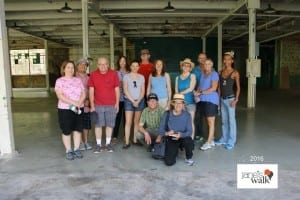In Dark Age Ahead (2004), Jane Jacobs outlines, with a sense of despair, as well as of hope, how we can protect and strengthen our culture and communities
A previous post is entitled:
I have an interest in the history of land-use decision making, a history that dates back millions of years. Human beings have been involved with land-use decision making for many years, as have plants and animals. Geological and intergalactic processes associated with the origins of life on Earth are also are also part of the history of land-use decision making.

May 5, 2018 Jane’s Walk stops to admire a Cottage Era house at the corner of Long Branch Ave. and Muskoka Ave. Jaan Pill photo
With regard to land-use decision making directed and managed by human beings, we can speak of a history of cultures of land-use decision making. Or, if we wish, we can speak of the cultural history of land-use planning.
The above-mentioned previous post refers to the central role that culture can play, in the event it is skilfully put to good use, in the rebuilding of cities that have fallen upon traumatic, difficult, or discouraging circumstances.
The previous post also brings to mind, for me, the legacy of Jane Jacobs, who spent a lot of time thinking about the role that culture has played in history, and about the role that culture can play in the present moment.

Small Arms Building – Then and Now: May 28, 2016 Jane’s Walk in Mississauga. Photo source: Gabriella Bank Facebook page
For many years, I was involved in co-leading and later in organizing Jane’s Walks in Etobicoke and Mississauga. Like many people, I am impressed with the legacy of Jane Jacobs, whose life work gave rise, after she had passed away, to the Jane’s Walk concept.
In her book entitled Dark Age Ahead (2004), Jane Jacobs underlines how culture, when suitably nurtured and put to good use, can save us from disaster.
This is a first-rate study, in my view, and I’m pleased that I’ve had the time in recent weeks to read parts of it closely.
I very much like the fact that Jane Jacobs occupied a borderland between a do-it-yourself approach to education, on the one hand, and a strictly academic approach to education. I feel very much at home, in occupying such a borderland.
Jane Jacobs and Erving Goffman
Jacobs had a unique capacity to read a street, or transportation system, in a way that was highly perceptive. She also had a flair, refined in the course of many years of work as a first-rate professional writer, in communicating her observations. During the Depression as a young woman in the 1930s, Jacobs worked as a volunteer newspaper reporter, in exchange for the newspaper staff’s “generous tutoring” (Dark Age Ahead (2004), p. 54). At a subsequent stage of her writing career, she was hired as an editor and writer for an architectural journal.
I am reminded of another observer, who like Jacobs had a unique and original capacity to observe things closely, in a way of seeing, and sensing, that can be characterized as remarkably apt, and perceptive.
That observer was the sociologist (sometimes also termed social psychologist, and sometimes described as Canadian, at other times as American) Erving Goffman, whose speciality was the close observation of everyday social interactions. Jane Jacobs also observed things closely, at a somewhat wider scale – in terms, that is, of what I would describe as cultures of land-use decision making. Each demonstrated a unique, and celebrated, capacity for perspicacity – for a formidable and inspiring keenness of mental perception and understanding.
Among other things, Jacobs speaks in Dark Age Ahead of a factory in Brampton that, at the time her book was being written, served as the corporate headquarters for Nortel, a huge corporation that, in the years after the book was published, went belly-up. The factory, as the book describes it, was beautifully repurposed as a cosy and comfortable setting, for Nortel employees.
In further reading online, by way of following up on the post-Nortel history of the building, I’ve learned that the property was subsequently purchased by Rogers Communications and, to my knowledge, continues to function as a great setting for a corporate headquarters.
Blurb from Dark Age Ahead (2004)
The following blurb (I’ve added the bullet points, by way of changing the layout of the text) from Dark Age Ahead highlights the book’s key themes:
Visionary thinker Jane Jacobs uses her authoritative work on urban life and economies to show us how we can protect and strengthen our culture and communities. In Dark Age Ahead, Jane Jacobs identifies five pillars of our culture that we depend on but which are in serious decline:
- community and family;
- higher education;
- the effective practice of science;
- taxation and government; and
- self-policing by learned professions.
The decay of these pillars, Jacobs contends, is behind such ills as environmental crisis, racism and the growing gulf between rich and poor; their continued degradation could lead us into a new Dark Age, a period of cultural collapse in which all that keeps a society alive and vibrant is forgotten.
But this is a hopeful book as well as a warning. Jacobs draws on her vast frame of reference – from fifteenth-century Chinese shipbuilding to zoning regulations in Brampton, Ontario – and in highly readable, invigorating prose offers proposals that could arrest the cycles of decay and turn them into beneficent ones. Wise, worldly, full of real-life examples and accessible concepts, this book is an essential read for perilous times.
[End]

Leave a Reply
Want to join the discussion?Feel free to contribute!